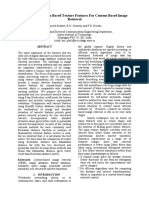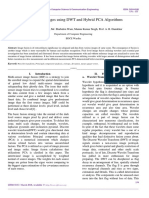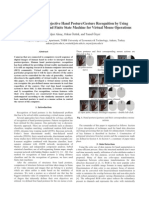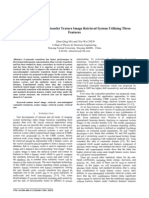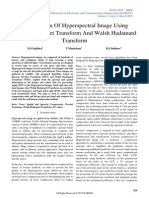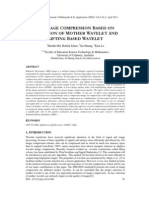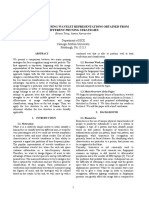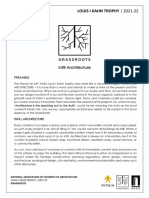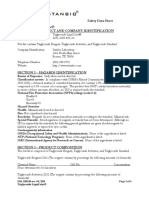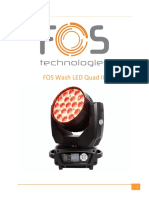Efficient Image Retrieval
Efficient Image Retrieval
Uploaded by
Marchelius KalvinCopyright:
Available Formats
Efficient Image Retrieval
Efficient Image Retrieval
Uploaded by
Marchelius KalvinOriginal Description:
Copyright
Available Formats
Share this document
Did you find this document useful?
Is this content inappropriate?
Copyright:
Available Formats
Efficient Image Retrieval
Efficient Image Retrieval
Uploaded by
Marchelius KalvinCopyright:
Available Formats
Signal & Image Processing : An International Journal (SIPIJ) Vol.4, No.
3, June 2013
DOI : 10.5121/sipij.2013.4302 17
EFFICIENT IMAGE RETRIEVAL USING REGION
BASED IMAGE RETRIEVAL
Niket Amoda and Ramesh K Kulkarni
Department of Electronics and Telecommunication Engineering,
Vivekanand Institute of Technology, University of Mumbai
M.G. Road Fort, Mumbai, India
niketamoda@gmail.com
rk1_2002@yahoo.com
ABSTRACT
Early image retrieval techniques were based on textual annotation of images. Manual annotation of images
is a burdensome and expensive work for a huge image database. It is often introspective, context-sensitive
and crude. Content based image retrieval, is implemented using the optical constituents of an image such
as shape, colour, spatial layout, and texture to exhibit and index the image. The Region Based Image
Retrieval (RBIR) system uses the Discrete Wavelet Transform (DWT) and a k-means clustering algorithm
to segment an image into regions. Each region of the image is represented by a set of optical
characteristics and the likeness between regions and is measured using a particular metric function on
such characteristics.
KEYWORDS
Content based image retrieval, K-Means Algorithm, Discrete Wavelet Transform, Region Based Image
Retrieval.
1. INTRODUCTION
Early image retrieval techniques were based on textual annotation of images. By using text
descriptions, images can be arranged by topical or syntactic classification to simplify navigation
and browsing on the basis of standard Boolean queries. It was well admitted that a more
accomplished and direct method to exhibit and index optical information would be based upon
the fundamental characteristics of the images themselves.
Content based image retrieval, is implemented using the optical constituents of an image such as
shape, colour, spatial layout, and texture to exhibit and index the image. In ideal content based
image retrieval systems, the optical characteristics of the images in the database are extracted and
illustrated by multi-dimensional feature vectors. The feature vectors of the images present in the
database result in formation of a feature database.
Signal & Image Processing : An International Journal (SIPIJ) Vol.4, No.3, June 2013
18
For image retrieval, the users feeds example images or sketched figures to the retrieval system.
The system then converts these examples images into its internal representation of feature
vectors. The similarities / distances between the feature vectors of the query example or sketch
and those of the images available in the image database are then computed and retrieval is
performed using an indexing scheme. The indexing scheme gives an efficient approach to
examine the image database.
Present-day retrieval systems have included users' relevance feedback to adjust the retrieval
process in order to create perceptually and semantically more accurate retrieval results.
An optical content descriptor could be either local or global. A global descriptor uses the optical
characteristics of the whole image, whereas a local descriptor uses the optical characteristics of
regions or objects to describe the image content. In order to acquire the local visual descriptors,
an image is often segmented into parts first.
Some of the widely used techniques for extracting color, texture, shape and spatial relationship
features from images are now described briefly.
Instead of exact matching, content based image retrieval systems calculate the visual similarities
between a query image and the images in a database. The result of the retrieval is not just a single
image but, a list of images arranged according to their similarities with the query image. Different
types of similarity/distance measures will influence the performances of an image retrieval
system considerably. Commonly used similarity measures are: Mahalanobis Distance, Euclidean
Distance and Bhattacharyya Distance.
One of the important issues in content-based image retrieval is effective indexing and faster
image retrieval on the basis of optical characteristics. Since the feature vectors of images tend to
have high dimensionality and hence they are not suitable for conventional indexing structures,
dimension reduction is usually done before setting up an efective indexing scheme. Principal
component analysis (PCA) is also one of the methods commonly used for dimension reduction. In
this method we linearly map input data to a coordinate space, so that the axes are aligned to
reflect the maximum variations in the data.
After reduction of dimension, the indexing of multi-dimensional data is done. There are various
methods available for this purpose, such as R-tree (particularly, R*-tree), K-d-B tree, Linear
quad-trees and Grid files etc.
2. WAVELET TRANSFORMS
The signals produced from natural sources such as digital images often have non-stationary
attributes i.e. their content are variable in time or space.
Frequency analysis of stationary signals can be effectively achieved by projecting the signal onto
a set of infinite spatial extent basis functions using the Fourier transform:
=
(1)
Signal & Image Processing : An International Journal (SIPIJ) Vol.4, No.3, June 2013
19
where X(f) represents the global frequency of the signal. Similarly, effective frequency analysis
of non-stationary signals can be achieved by projecting the signal onto a set of spatially localized
basis functions using the wavelet transform.
a, b = xt
tdt
,
(2)
where a, b R and ab(t) is the translated and scaled version of the mother wavelet (t) given by
,
=
(3)
Different choices of a and b result in the many different possible wavelet bases at different scales
and translations.
A. Discrete Wavelet Transform (DWT)
The continuous convolution for discrete case the in the above equation is replaced by the
following discrete summation:
,
= ,
,
,
(4)
where c
m,n
are the wavelet coefficients. The implementation of the convolution of the scaling
function with the signal is done at each scale through the iterative filtering of the signal with a
low pass FIR filter h
n.
At each scale the approximation coefficients a
m,n
can be obtained using the
following recursive relationship:
,
=
,
(5)
where a
0,n
is the sampled signal itself. In addition to this, if we use a related high pass FIR filter g
n
the wavelet coefficients is obtained using the further recursive relation:
,
=
,
(6)
In reconstruction of the original signal, the analysis filters can be selected from a biorthogonal set
having a related set of synthesis filters. The synthesis filters g
~
and h
~
can be used to perfectly
rebuild the signal using the reconstruction formula:
,
=
,
+
(7)
B. Extension of DWT to Two Dimensions
To extend the wavelet transform to two dimensions it is just necessary to separately filter and
down sample in the horizontal and vertical directions. This produces four subbands at each scale.
Denoting the horizontal frequency and followed by the vertical frequency, generates high-high
(HH), high-low (HL), low-high (LH) and low-low (LL) image subbands. We can recursively
apply the same scheme to the low-low subband a multiresolution decomposition can be obtained.
Signal & Image Processing : An International Journal (SIPIJ) Vol.4, No.3, June 2013
20
Figure 1(a) shows the normal layout of such a wavelet decomposition. The subbands are sensitive
to frequencies at that scale and the LH, HL and HH subbands are sensitive to vertical, horizontal
and diagonal frequencies respectively. Figure 1(b) shows a DWT decomposition of a texture
image. This image shows the variation between wavelet subbands highlighting the scale and
orientation selectivity of the transform. Also, Figure 1(d) shows a DWT decomposition of the
Barbara test image (shown in Figure 1(c)). This image also shows the scale and orientation
selectivity of the DWT. High energy subband regions pick out the texture content at different
scales and orientations.
1 (a) Labelled Subbands 1(b) Magnitude of DWT of Texture image
1 (c) Barbara Test Image 1 (d) Magnitude of DWT of Barbara Image
Fig: 1 Two Dimensional Wavelet Transform
C. Extension of DWT to Two Dimensions
Haar function is one of the oldest and simplest example of a mother wavelet function. It is
composed of a pair of rectangular pulses:
=
1 0
1
0
(8)
A standard two-dimensional Haar wavelet decomposition of an image is very simple to code. It
involves a one-dimensional decomposition on each row of the image, followed by a one-
dimensional decomposition on each column of the result.
3. REGION BASED IMAGE RETRIEVAL
The Region Based Image Retrieval (RBIR) system uses the Discrete Wavelet Transform (DWT)
and a k-means clustering algorithm to segment an image into regions. Each region is defined by
Signal & Image Processing : An International Journal (SIPIJ) Vol.4, No.3, June 2013
21
means of a set of characteristics and the alikeness between the regions is measured using a
specific metric function on such characteristics. The implementation of RBIR can be divided into
two parts: Image Pre-processing and Image Retrieval.
A. Image Pre-processing
The detailed algorithm for the pre-processing stage is given below.
Fig: 2 Flow Diagram
The algorithm requires that all the images in the database and the query image be of the same
size. A size of 128*192 was chosen for all of the images. If the image had a different size, it was
first resized to 128*192 and then the pre-processing operations were carried out on the image.
Start
Read Images into
the Database
Resize each Image to size 128*192
Convert the Images from
RGB to HSV Color Space
Perform 3 Level Haar Wavelet Decomposition
of each Color Channel separately
Implement k-means clustering algorithm
on 3-D Wavelet coefficients of
Approximation Subband of last Level
Using the Mask obtained after Clustering, extract
Regions from the 4 Subbands of the last Level
Calculate the Size, Mean and Covariance of
each Region and store in Feature Database
Stop
Signal & Image Processing : An International Journal (SIPIJ) Vol.4, No.3, June 2013
22
In the RBIR application, each image is divided into the corresponding color channels (i.e. H, S
and V) and the DWT was applied separately to each color channel. The j-th Wavelet coefficient
of subband B (B {LL, LH, HL, HH}, where L stands for low and H for high) and DWT
level l is a 3-D vector i.e.
;
=
;
,
;
,
;
(9)
Where each component refers to a color channel c (c {0, 1, 2}). The energy of w
j
l;B
on the c and
d channels is then defined as:
;
=
;
.
;
(10)
When c=d, e
cc
j
l;B
is called the channel energy of channel c, whereas when cd, e
cd
j
l;B
is termed the
cross-correlation energy between channels c and d. The energy vector
;
=
;
,
;
,
;
,
;
,
;
,
;
(11)
captures both color and texture information through channel and cross-correlation energies,
respectively. This is known to be one of the most robust methods for the representation of texture
features.
K-Means Clustering: The k-means algorithm segments the observations in the given data into k
mutually exclusive clusters, and returns a vector of indices denoting which of the k clusters it has
assigned each observation.
Each cluster is defined on the basis of its member objects and its centroid. The centroid for
individual cluster is the point to which the sum of distances from all objects in that cluster or
partition is minimized.
+ +
(12)
While using the Euclidean distance, each centroid is calculated as the mean of the points present
in the cluster. For example, if the data set is 3 D and the cluster has two points: X = (x1, x2, x3)
and Y = (y1, y2, y3), then the centroid Z becomes Z = (z1, z2, z3), where z1 = (x1 + y1)/2 and z2
= (x2 + y2)/2 and z3 = (x3 + y3)/2.
The k-means algorithm is a two-phase iterative algorithm which minimizes the sum of point-to-
centroid distances, summed over all k segments:
1) In the first phase we use what the literature often describes as "batch" updates, where
each iteration contains reassigning points to their closest segment centroid, all at once,
followed by recalculation of segment centroids. This phase supplies a fast but potentially
only approximate solution as a beginning point for the second phase.
2) In the second phase we use what the literature often describes as "on-line" updates, where
points are independently reassigned if doing so will decrease the sum of distances, and
segment centroids are recalculated after each reassignment. Each iteration during the
second phase contains one pass though all the points.
Signal & Image Processing : An International Journal (SIPIJ) Vol.4, No.3, June 2013
23
B. Image Retrieval
The detailed algorithm for the Image Retrieval phase is given below.
Fig: 3 Flow Diagram
After reading the query image, the same pre-processing operations of image resizing, RGB to
HSV conversion, DWT decomposition, k-means clustering and feature extraction must be
performed on the query image. At the end of the pre-processing operation, the sizes, mean vectors
and covariance matrices of the regions of the query image would be obtained.
Region Similarity : The similarity between two regions Rq,i (represented by the feature vector
[Rq,i, CRq,i3, size(Rq,i)] of a query image Iq and Rs,j (represented by the feature vector [Rs,j,
CRs,j3, size(Rs,j)]) of a database image Is is computed as
Start
Read Query Image
Perform Pre-processing
operations on Query Image
Compute Region Similarity Scores
between each region of Query Image
and all regions of Database Images
Perform Optimal Region Matching
Compute Image Similarity Scores
Sort the Image Similarity Scores
Display 10
best Results
Stop
Signal & Image Processing : An International Journal (SIPIJ) Vol.4, No.3, June 2013
24
,
,
,
=
,
,
,
(13)
where d() is a distance function. The distance d(R
q,i
, R
s,j
) between the regions R
q,i
and R
s,j
is a
weighted sum, taken over the four frequency subbands, of the distances between color-texture
descriptors, plus an additional term that takes into account the difference between the relative
sizes of the two regions.
In the present work, all the frequency coefficients are equally weighed i.e. B = 1 for B {LL,
LH, HL, HH}. The second term takes into account the difference in size between the regions by
multiplying it with a coefficient that favors matches between large regions. The distance dB(Rq,i,
Rs,j) between two regions on the frequency subband B is computed by using the Bhattacharyya
Metric:
,
,
,
=
1
2
,
;
+
,
;
2
,
;
,
;
+
1
8
,
;
+
,
;
2
.............................. (14)
4. IMPLEMENTATION OF RBIR
After the optimal region assignment has been performed, the next step is to compute the Image
Similarity Score. This score is obtained by simply adding the region similarity scores of the
matched regions. The final step is to sort the image similarity scores so obtained and then display
the images having the least distance from the query image.
Adding Images to the Database: The steps involved in adding images to the database are:
1) Run the Feature Database Generation Population program. A Matlab GUI appears as
shown in Figure 4
2) Select the images from the folder Image_Database and click on Add to generate a
feature database.
3) The images selected will appear in the listbox.
4) Click on the Done after selecting the images to be added to the database.
5) Feature Database of the image will be generated.
Signal & Image Processing : An International Journal (SIPIJ) Vol.4, No.3, June 2013
25
Fig: 4 Feature Database population
Image Retrieval: The steps involved in searching for images are:
1) Start the Region Based Image Retrieval program. A GUI appears as shown in Figure
5 (a).
2) Select a query image from the folder Image_Query.
3) The query image will be displayed Figure 5 (b) along with the 16 matches of the most
similar images available in the database.
Fig: 5 (a) Fig: 5 (b)
Fig: 5 Region Based Image Retrieval
5. RESULTS
To test the RBIR application, a database consisting of 180 general images, was used. The 180
images could roughly be categorized into 9 groups, each group consisting of 20 similar images. In
addition 9 query images, each query corresponding to one of the groups were taken.
Signal & Image Processing : An International Journal (SIPIJ) Vol.4, No.3, June 2013
26
Figure 6 shows an example of the results achieved using the RBIR application. From a semantic
point of view, the results obtained are particularly good i.e. all the images in this particular
example are of horses.
Fig: 6 RBIR Results
A. Partial Match Queries
A partial match query is a query that specifies only part of the image. In Figure 7, the query
image is obtained by cropping a database image. As the results show, the RBIR application gave
the complete image as the very first match.
Fig: 7 Partial Match Quering
B. Scanned Queries
During the scanning process of query image, it may suffer artifacts such as poor resolution,
misregistration, color shift and dithering effects.. To consider the effect of scanned images on the
retrieval effectiveness, the query image was first printed and then subsequently scanned. The
scanned image appeared fuzzier, darker and slightly misregistered compared to the original.
Figures 8 (a) and (b) displays the results obtained by the original query image and the scanned
query image respectively. It can be observed that there is a slight degradation in the quality of the
results obtained.
Signal & Image Processing : An International Journal (SIPIJ) Vol.4, No.3, June 2013
27
Fig: 8 (a) Result with Original Query
Fig: 8 (b) Result with Scanned Query
Fig: 8 Scanned Queries
C. Difficult Queries
The effectiveness of the RBIR application is confirmed when considering difficult queries, i.e.
queries having a low number of similar images in the database. Figure 9 shows the results for a
query having only two similar images in the database. The RBIR system is able to retrieves both
of these images.
Fig: 9 Difficult Queries
Signal & Image Processing : An International Journal (SIPIJ) Vol.4, No.3, June 2013
28
D. Search Time
For an image retrieval application, the time taken for retrieval is an extremely important
parameter. On the other hand, the time taken for pre-processing is not as important since the pre-
processing operations have to be carried out only once.
The first entry in table below shows the average time taken to perform the pre-processing
operations on the database of 180 images of size 128*192. The second entry shows the average
time taken during the image retrieval phase. Here again, the query image was of size 128*192.
The experimental setup consisted of a computer with a 2.4 GHz Intel(R) Core(TM)2 Duo CPU
and 3 GB of DDR2 PC RAM running MATLAB 7 on Windows 7 Eternity.
Pre-processing Stage 25.2 seconds
Image Retrieval Stage 1.7 seconds
6. CONCLUSIONS
Although the HSV color space was found to give better results compared to the RGB color space
in, in our experiments the RGB and HSV color spaces were found to give almost equivalent
results. Eventually, it was decided to use the HSV color space because it gave better results than
the RGB color space in case of difficult queries. The figure below shows that when using the
RGB color space, only one of the two matches was retrieved. On the other hand, in the HSV color
space, both the matches were retrieved.
REFERENCES
[1] D.Lowe, Object recognition from local scale-invariant features, in ICCV, 1999, pp. 11501157.
[2] Y.J.Zhang A survey on evaluation methods for image segmentation, Pattern Recognition 29 (8)
(1996) 1335 - 1340
[3] A.Jain, Data clustering: 50 years beyond k-means, Pattern Recognition Letters, vol. 31, no. 8, pp.
651 666, June 2010.
[4] W.Zhao, H.Ma, Q.He, "Parallel K-Means Clustering Based on MapReduce," in: Cloud Computing,
vol. 5931, pp. 674-679, 2009.
[5] W.D.Arthur, S. Vassilvitskii, K-means++: the Advantages of careful seeding, in Proc. 2007
Symposium on Discrete Algorithms, pp.1027-1035.
[6] Rafael C. Gonzalez, Richard E. Woods, " Digital Image Processing" , Second Edition, Prentice Hall
Upper Saddle River, New Jersey 07458, TA1632.G66 2001, 698-740
[7] Fast Multiresolution Image Querying, International Conference on Computer Graphics and
Interactive Techniques, 1995: Charles E.Jacobs, Adam Finkelstein, David H. Salesin
Signal & Image Processing : An International Journal (SIPIJ) Vol.4, No.3, June 2013
[8] Content-based Image Retrieval, A report to
John Eakins, Margaret Graham
[9] Fundamentals of Content-based Image Retrieval, Multimedia Information Retrieval and Management
- Technological Fundamentals and Applications, Springer, 2002: Dr.Fuhui Long
Zhang, Prof. David Dagan Feng
[10] Image Retrieval Current techniques, Promising directions and Open issues, Journal of Visual
Communication and Image Representation, 1999: Yong Rui, Thomas S.Huang, Shih
[11] Wavelet Based Texture Analysis and Segmentation for Image Retrieval and Fusion, Thesis,
University of Bristol, 2002: Paul R. Hill
[12] WINDSURF: A Region Based Image Retrieval System, Proceedings of the 10th International
Workshop on Database & Expert Systems Applicati
Patella
[13] P.Felzenszwalb, R.Girshick, D.McAllester, and D.Ramanan, Object detection with discriminatively
trained part based models,in IEEE Transactions on Pattern Analysis and Machine Intelligence, v
32, 2010.
Authors
Niket Amoda received his B.E. in Electronics & Communication Engineering from
Rajiv Gandhi Proudyogiki Vishwavidyalaya, B
completed his Diploma in Advance Computing from ACTS, Pune, India in 2008
and is M.E. scholar in Department of Electronics & Telecommunication
Engineering, Vivekanand Education Society's Institute of Technology (VESIT),
University of Mumbai, India. He worked as a Software Development Engineer in
Ford Motor Company, India from 2008 to 2009. He is currently working as a
Assistant Professor in Electronics & Telecommunication Engineering Department
of KC College of Engineering & Manag
publications in international journals and international conferences. His research area is Image processing.
He is also engaged in SAP certification from SAP Germany.
Dr. R. K. Kulkarni completed his PHD from, National Institute of Technology,
Rourkela, Orissa, India. He received his bachelor degree in Electronics &
Communication from Mysore University and master degree in Digital Electronics
form Karnataka University, Karnataka. H
journals and international conferences. His research area is Image processing, Non
Linear filters, and Digital signal processing.
Signal & Image Processing : An International Journal (SIPIJ) Vol.4, No.3, June 2013
based Image Retrieval, A report to the JISC Technology Applications Programme, 1999:
John Eakins, Margaret Graham
based Image Retrieval, Multimedia Information Retrieval and Management
Technological Fundamentals and Applications, Springer, 2002: Dr.Fuhui Long, Dr. Hongjiang
Zhang, Prof. David Dagan Feng
Current techniques, Promising directions and Open issues, Journal of Visual
Communication and Image Representation, 1999: Yong Rui, Thomas S.Huang, Shih-Fu Chang
Texture Analysis and Segmentation for Image Retrieval and Fusion, Thesis,
University of Bristol, 2002: Paul R. Hill
WINDSURF: A Region Based Image Retrieval System, Proceedings of the 10th International
Workshop on Database & Expert Systems Applications, 2000: Ilaria Bartolini, Paolo Ciaccia, Marco
P.Felzenszwalb, R.Girshick, D.McAllester, and D.Ramanan, Object detection with discriminatively
trained part based models,in IEEE Transactions on Pattern Analysis and Machine Intelligence, v
Niket Amoda received his B.E. in Electronics & Communication Engineering from
Rajiv Gandhi Proudyogiki Vishwavidyalaya, Bhopal, India, in 2006. He
completed his Diploma in Advance Computing from ACTS, Pune, India in 2008
and is M.E. scholar in Department of Electronics & Telecommunication
Engineering, Vivekanand Education Society's Institute of Technology (VESIT),
y of Mumbai, India. He worked as a Software Development Engineer in
Ford Motor Company, India from 2008 to 2009. He is currently working as a
Assistant Professor in Electronics & Telecommunication Engineering Department
of KC College of Engineering & Management & Research, Thane, India, since 2010 till date. He has many
publications in international journals and international conferences. His research area is Image processing.
He is also engaged in SAP certification from SAP Germany.
completed his PHD from, National Institute of Technology,
Rourkela, Orissa, India. He received his bachelor degree in Electronics &
Communication from Mysore University and master degree in Digital Electronics
form Karnataka University, Karnataka. He has many publications in international
journals and international conferences. His research area is Image processing, Non
Linear filters, and Digital signal processing.
Signal & Image Processing : An International Journal (SIPIJ) Vol.4, No.3, June 2013
29
the JISC Technology Applications Programme, 1999:
based Image Retrieval, Multimedia Information Retrieval and Management
, Dr. Hongjiang
Current techniques, Promising directions and Open issues, Journal of Visual
Fu Chang
Texture Analysis and Segmentation for Image Retrieval and Fusion, Thesis,
WINDSURF: A Region Based Image Retrieval System, Proceedings of the 10th International
ons, 2000: Ilaria Bartolini, Paolo Ciaccia, Marco
P.Felzenszwalb, R.Girshick, D.McAllester, and D.Ramanan, Object detection with discriminatively
trained part based models,in IEEE Transactions on Pattern Analysis and Machine Intelligence, vol.
since 2010 till date. He has many
publications in international journals and international conferences. His research area is Image processing.
You might also like
- Data Sheet For PSVDocument1 pageData Sheet For PSVBABILIN VNo ratings yet
- E I R U R B I R: Fficient Mage Etrieval Sing Egion Ased Mage EtrievalDocument13 pagesE I R U R B I R: Fficient Mage Etrieval Sing Egion Ased Mage EtrievalsipijNo ratings yet
- A Novel Statistical Fusion Rule For Image Fusion and Its Comparison in Non Subsampled Contourlet Transform Domain and Wavelet DomainDocument19 pagesA Novel Statistical Fusion Rule For Image Fusion and Its Comparison in Non Subsampled Contourlet Transform Domain and Wavelet DomainIJMAJournalNo ratings yet
- Image Fusion Using DWT & PCA: International Journal of Advanced Research in Computer Science and Software EngineeringDocument5 pagesImage Fusion Using DWT & PCA: International Journal of Advanced Research in Computer Science and Software EngineeringRudresh RakeshNo ratings yet
- Student AttendanceDocument50 pagesStudent AttendanceHarikrishnan ShunmugamNo ratings yet
- Region Contrast Based Salient Object Detection: Sayali Doifode, Prof.M.B.ZalteDocument3 pagesRegion Contrast Based Salient Object Detection: Sayali Doifode, Prof.M.B.ZalteerpublicationNo ratings yet
- Wavelet Transform Based Texture Features For Content Based Image RetrievalDocument5 pagesWavelet Transform Based Texture Features For Content Based Image RetrievalAdhy RizaldyNo ratings yet
- University of Zawia Faculty of Engineering: Performance of Different Transforms On Image ContourDocument51 pagesUniversity of Zawia Faculty of Engineering: Performance of Different Transforms On Image ContourAhmed HwaidiNo ratings yet
- WebMedia CarolinaWatanabe Et AlDocument8 pagesWebMedia CarolinaWatanabe Et AlCarolina WatanabeNo ratings yet
- Fusing Two Images Using DWT and Hybrid PCA AlgorithmsDocument4 pagesFusing Two Images Using DWT and Hybrid PCA AlgorithmsRahul SharmaNo ratings yet
- Wavelet Based Comparison of Edge Detection Technique For Iris RecognitionDocument4 pagesWavelet Based Comparison of Edge Detection Technique For Iris RecognitionIJERDNo ratings yet
- Sketch-to-Sketch Match With Dice Similarity MeasuresDocument6 pagesSketch-to-Sketch Match With Dice Similarity MeasuresInternational Journal of Application or Innovation in Engineering & ManagementNo ratings yet
- Image Segmentation and Detection Using Watershed Transform and Region Based Image RetrievalDocument6 pagesImage Segmentation and Detection Using Watershed Transform and Region Based Image RetrievalInternational Journal of Application or Innovation in Engineering & ManagementNo ratings yet
- Investigation of Compressed Image Segmentation: S.Raja, S.Sankar, S.SaravanakumarDocument4 pagesInvestigation of Compressed Image Segmentation: S.Raja, S.Sankar, S.SaravanakumarerpublicationNo ratings yet
- Image Retrieval Using Both Color and Texture FeaturesDocument6 pagesImage Retrieval Using Both Color and Texture Featuresdivyaa76No ratings yet
- Wavelet Enhancement of Cloud-Related Shadow Areas in Single Landsat Satellite ImageryDocument6 pagesWavelet Enhancement of Cloud-Related Shadow Areas in Single Landsat Satellite ImagerySrikanth PatilNo ratings yet
- Color Image Enhancement Techniques A Critical ReviDocument7 pagesColor Image Enhancement Techniques A Critical Revifahim6285No ratings yet
- Good PaperDocument5 pagesGood Paperujjwal919No ratings yet
- Non-Subsampled Contourlet Texture Image Retrieval System Utilizing Three Features Zhan-Qing and Xin-WuDocument4 pagesNon-Subsampled Contourlet Texture Image Retrieval System Utilizing Three Features Zhan-Qing and Xin-WuRajesh VeerabadranNo ratings yet
- Ijarece Vol 2 Issue 3 314 319Document6 pagesIjarece Vol 2 Issue 3 314 319rnagu1969No ratings yet
- Visual Image Search: Feature Signatures Or/and Global DescriptorsDocument15 pagesVisual Image Search: Feature Signatures Or/and Global DescriptorsPiyush Dongre (TechieToons)No ratings yet
- Retrieval of Color Image Using Color Correlogram and Wavelet FiltersDocument4 pagesRetrieval of Color Image Using Color Correlogram and Wavelet FiltersNguyễnTrungKiênNo ratings yet
- Guided Filter and Discrete Wavelet Transform Based Medical Image Fusion Using Image StatisticsDocument10 pagesGuided Filter and Discrete Wavelet Transform Based Medical Image Fusion Using Image StatisticsswapnaNo ratings yet
- Obtaining Super-Resolution Images by Combining Low-Resolution Images With High-Frequency Information Derivedfrom Training ImagesDocument13 pagesObtaining Super-Resolution Images by Combining Low-Resolution Images With High-Frequency Information Derivedfrom Training ImagesAnonymous Gl4IRRjzNNo ratings yet
- MR Image Compression Based On Selection of Mother Wavelet and Lifting Based WaveletDocument18 pagesMR Image Compression Based On Selection of Mother Wavelet and Lifting Based WaveletIJMAJournalNo ratings yet
- Image Restoration Part 1Document5 pagesImage Restoration Part 1Nishi YadavNo ratings yet
- An Improved Underwater Image Enhancement TechniqueDocument6 pagesAn Improved Underwater Image Enhancement TechniqueIJRASETPublicationsNo ratings yet
- Image Fusion: International Journal of Advanced Research in Computer Science and Software EngineeringDocument4 pagesImage Fusion: International Journal of Advanced Research in Computer Science and Software EngineeringIdris Khan PathanNo ratings yet
- Effective Method of Image Retrieval Using Markov Random Field With Hough TransformDocument6 pagesEffective Method of Image Retrieval Using Markov Random Field With Hough TransformEditor IJRITCCNo ratings yet
- Exploring Spatial Information in Spectral Features For Texture Image RetrievalDocument4 pagesExploring Spatial Information in Spectral Features For Texture Image Retrievalvol1no3No ratings yet
- Phase-Driven Finite Element Model For Spatio-Temporal Tracking in Tagged Cardiac MRIDocument8 pagesPhase-Driven Finite Element Model For Spatio-Temporal Tracking in Tagged Cardiac MRIJeremias TabordaNo ratings yet
- CBIR Based On Color and Texture Features Using DCT and DWTDocument3 pagesCBIR Based On Color and Texture Features Using DCT and DWTerpublicationNo ratings yet
- Different Image Fusion Techniques - A Critical ReviewDocument4 pagesDifferent Image Fusion Techniques - A Critical ReviewIJMERNo ratings yet
- Semi Supervised Biased Maximum Margin Analysis For Interactive Image RetrievalDocument62 pagesSemi Supervised Biased Maximum Margin Analysis For Interactive Image RetrievalkhshethNo ratings yet
- IT AssignmentDocument14 pagesIT AssignmentChandan KumarNo ratings yet
- 15arspc Submission 109Document9 pages15arspc Submission 109reneebartoloNo ratings yet
- Texture Features For Browsing and Retrieval of Image Data: Manjunathi and W.YDocument6 pagesTexture Features For Browsing and Retrieval of Image Data: Manjunathi and W.YMorigia SimanjuntakNo ratings yet
- Face Recog Using Wavelet Transformations PDFDocument5 pagesFace Recog Using Wavelet Transformations PDFRahul JainNo ratings yet
- Different Image Fusion Techniques - A Critical Review: Deepak Kumar Sahu, M.P.ParsaiDocument4 pagesDifferent Image Fusion Techniques - A Critical Review: Deepak Kumar Sahu, M.P.ParsaiCatalina GireadaNo ratings yet
- Content Based Image Retrieval Using Hybrid Features and Various Distance Metric 2018-56Document15 pagesContent Based Image Retrieval Using Hybrid Features and Various Distance Metric 2018-56Thu Trang Nguyễn ThịNo ratings yet
- Image Fusion PresentationDocument33 pagesImage Fusion PresentationManthan Bhatt100% (1)
- Image Denoising Via Self-Learning Based Image Decomposition Using DWTDocument7 pagesImage Denoising Via Self-Learning Based Image Decomposition Using DWTASHOK KNo ratings yet
- Fusion of Two Images Using DWT and PCA MethodologyDocument4 pagesFusion of Two Images Using DWT and PCA MethodologyEditor IJRITCCNo ratings yet
- MC0086Document14 pagesMC0086puneetchawla2003No ratings yet
- Bio-Medical Image Enhancement Based On Spatial Domain TechniqueDocument5 pagesBio-Medical Image Enhancement Based On Spatial Domain TechniqueAnshik BansalNo ratings yet
- CCR Clustering and Collaborative RepresentationDocument93 pagesCCR Clustering and Collaborative Representationg_31682896No ratings yet
- Under Water Image Enhancement Using Discrete Cosine TransformDocument4 pagesUnder Water Image Enhancement Using Discrete Cosine Transformanil kasotNo ratings yet
- Wavelet Transform Techniques For Image Resolution EnhancementDocument6 pagesWavelet Transform Techniques For Image Resolution EnhancementerpublicationNo ratings yet
- Image Semantic Classification Using SVM in Image Retrieval: Xiaohong Yu, and Hong LiuDocument4 pagesImage Semantic Classification Using SVM in Image Retrieval: Xiaohong Yu, and Hong LiuNeha GundreNo ratings yet
- Presentation Title: Subheading Goes HereDocument54 pagesPresentation Title: Subheading Goes HereAhmed HwaidiNo ratings yet
- Contour Detection and Hierarchical Image SegmentationDocument19 pagesContour Detection and Hierarchical Image SegmentationQuynhtrang NguyenNo ratings yet
- WASJ 2015 402eDocument5 pagesWASJ 2015 402esuryabmepco23No ratings yet
- An Efficient CBIR Technique With YUV Color Space and Texture FeaturesDocument7 pagesAn Efficient CBIR Technique With YUV Color Space and Texture FeaturesiisteNo ratings yet
- Vision Tek Ieee 2013 Dip ProjectsDocument56 pagesVision Tek Ieee 2013 Dip ProjectskirankumarperamNo ratings yet
- DSA Image Registration Based On Multiscale Gabor Filters and Mutual InformationDocument6 pagesDSA Image Registration Based On Multiscale Gabor Filters and Mutual InformationerdoganaaaNo ratings yet
- Optical Flow: Exploring Dynamic Visual Patterns in Computer VisionFrom EverandOptical Flow: Exploring Dynamic Visual Patterns in Computer VisionNo ratings yet
- Standard and Super-Resolution Bioimaging Data Analysis: A PrimerFrom EverandStandard and Super-Resolution Bioimaging Data Analysis: A PrimerNo ratings yet
- Computer Stereo Vision: Exploring Depth Perception in Computer VisionFrom EverandComputer Stereo Vision: Exploring Depth Perception in Computer VisionNo ratings yet
- Measurements-Based Radar Signature Modeling: An Analysis FrameworkFrom EverandMeasurements-Based Radar Signature Modeling: An Analysis FrameworkNo ratings yet
- Histogram Equalization: Enhancing Image Contrast for Enhanced Visual PerceptionFrom EverandHistogram Equalization: Enhancing Image Contrast for Enhanced Visual PerceptionNo ratings yet
- Components Key - ComponentsDocument3 pagesComponents Key - ComponentsMarchelius KalvinNo ratings yet
- Prosedur Perencanaan Operasi Dan PemeliharaanDocument2 pagesProsedur Perencanaan Operasi Dan PemeliharaanMarchelius KalvinNo ratings yet
- Prosedur Penanganan Bahan Secara Manual & Mekanis: 1. TujuanDocument2 pagesProsedur Penanganan Bahan Secara Manual & Mekanis: 1. TujuanMarchelius Kalvin100% (1)
- Prosedur Penanganan Bahan Secara Manual & Mekanis: 1. TujuanDocument2 pagesProsedur Penanganan Bahan Secara Manual & Mekanis: 1. TujuanMarchelius Kalvin100% (1)
- Perbandingan PN2021 Dan PN2071Document5 pagesPerbandingan PN2021 Dan PN2071Marchelius KalvinNo ratings yet
- Connection Technology: Product CharacteristicsDocument1 pageConnection Technology: Product CharacteristicsMarchelius KalvinNo ratings yet
- IS5026 Operating InstructionDocument3 pagesIS5026 Operating InstructionMarchelius KalvinNo ratings yet
- BJTDocument36 pagesBJTMarchelius KalvinNo ratings yet
- Vintage Café Vol 13Document2 pagesVintage Café Vol 13vanciocNo ratings yet
- EBC MCQ Preparation Key PointsDocument20 pagesEBC MCQ Preparation Key PointsbhattparthivNo ratings yet
- 155-01ppr - MAN Alpha CPPDocument16 pages155-01ppr - MAN Alpha CPPhpss77No ratings yet
- A RM 105 19 18 096 SourDocument5 pagesA RM 105 19 18 096 SourGuilherme RochaNo ratings yet
- Louis I Kahn Trophy 2021-22 BriefDocument7 pagesLouis I Kahn Trophy 2021-22 BriefMadhav D NairNo ratings yet
- Top 30 MCQ Revolution of IndiaDocument4 pagesTop 30 MCQ Revolution of IndiaEthan HuntNo ratings yet
- ZTH2506 2Document1 pageZTH2506 2WarishNo ratings yet
- BC108 PDFDocument7 pagesBC108 PDFOsman KoçakNo ratings yet
- Christmas in FranceDocument8 pagesChristmas in FranceBărbânță DenisNo ratings yet
- Present Simple Vs Present Continuous ExercisesDocument2 pagesPresent Simple Vs Present Continuous ExercisesRebecca RamanathanNo ratings yet
- Allergens: GlutenDocument2 pagesAllergens: GlutenizabelleNo ratings yet
- Compiled AssistantshipsDocument15 pagesCompiled AssistantshipsROBI PAULNo ratings yet
- ATA-100 - TABLA ATA-SUB ATA Rev.2 PDFDocument1 pageATA-100 - TABLA ATA-SUB ATA Rev.2 PDFTincho Cuevas100% (1)
- AlvinT Price List 2016 - IDR - Okt2016 PDFDocument5 pagesAlvinT Price List 2016 - IDR - Okt2016 PDFDavid Epson Mayer0% (1)
- The Curse: PrologueDocument22 pagesThe Curse: PrologueLee DaNo ratings yet
- Thermodynamics Kinetics 4 Biological Science - HammesDocument180 pagesThermodynamics Kinetics 4 Biological Science - Hammeshsteele2013No ratings yet
- 5 - Trichomonas VaginalisDocument16 pages5 - Trichomonas Vaginalisعبد الرحمن حامدNo ratings yet
- S C R S C: Ymptom Lusters Elated To Pecific AncersDocument6 pagesS C R S C: Ymptom Lusters Elated To Pecific AncersDip Ayan MNo ratings yet
- MSDS - Stanbio TrigliseridaDocument4 pagesMSDS - Stanbio TrigliseridaDoni Eka Prasetiyo100% (1)
- Centrifugal CompressorsDocument27 pagesCentrifugal CompressorsMike Mukesh100% (1)
- Balcanica: Institute For Balkan StudiesDocument21 pagesBalcanica: Institute For Balkan StudiesGajevic SlavenNo ratings yet
- Products 1 2 1 480Document8 pagesProducts 1 2 1 480Михаил ЛазаревичNo ratings yet
- Jump DiscontinuitiesDocument6 pagesJump DiscontinuitiesjeffconnorsNo ratings yet
- USCAT19 - 85 51 - Hose Clamp Pliers For Click ClampsDocument1 pageUSCAT19 - 85 51 - Hose Clamp Pliers For Click ClampsthailanNo ratings yet
- Bosch Motronic Basic Motronic 1.1 1.2 1Document53 pagesBosch Motronic Basic Motronic 1.1 1.2 1Danniel PizattoNo ratings yet
- Lecture 10 - Types of Garden Styles - Part 3Document22 pagesLecture 10 - Types of Garden Styles - Part 3Rewaa MerwadNo ratings yet
- True/False. Two Points Each. Encircle Your Answer. These Questions Are Not Meant To Trick. IfDocument3 pagesTrue/False. Two Points Each. Encircle Your Answer. These Questions Are Not Meant To Trick. IfRenee KwokNo ratings yet
- Surface Sizing BasicsDocument4 pagesSurface Sizing BasicsPeter de Clerck100% (1)
- Question 5 and 6Document7 pagesQuestion 5 and 6tony frank100% (1)






